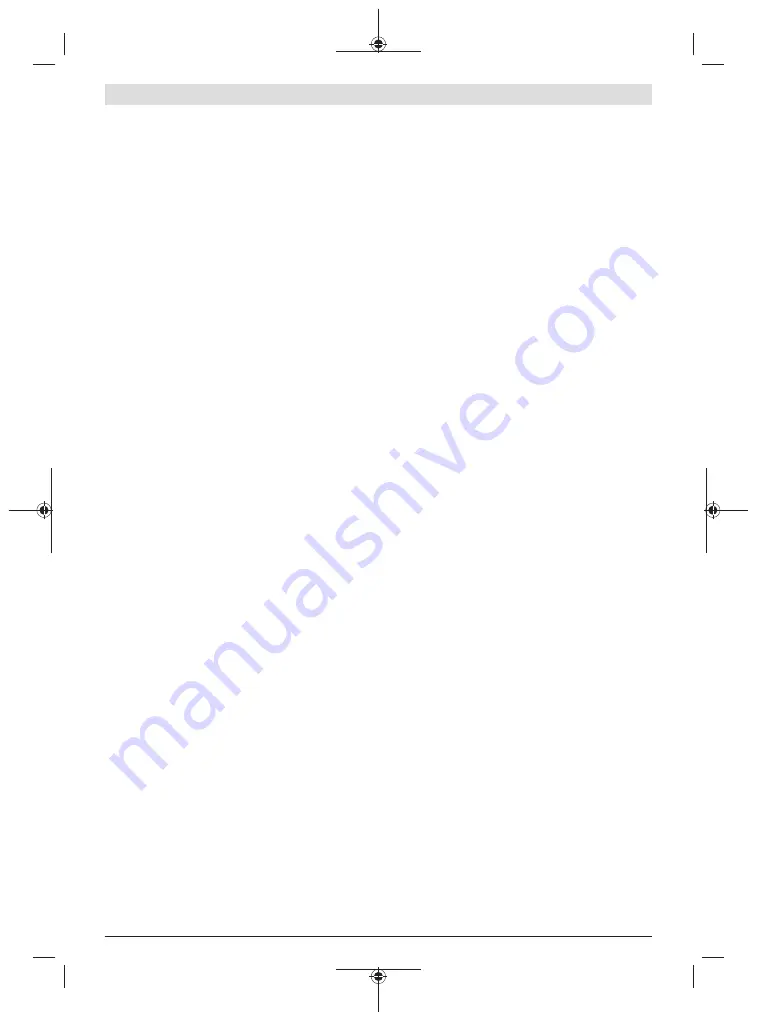
English |
11
The area outside these colder temperatures is shown as a
real image in grey scale to prevent coloured objects from
being wrongly associated with temperatures (e.g. a blue
window frame when searching for faulty insulation). Ad-
just the scale using the up arrow button
(7)
and down ar-
row button
(12)
. This expands or reduces the temperat-
ure range, thereby expanding or reducing the thermal im-
age. The measuring tool continues to measure minimum
and maximum temperatures and displays these at the
ends of the scale
(h)
.
–
<Manual>
If greatly deviating temperatures are measured in the
thermal image (e.g. a radiator as a hot object when
searching for thermal bridges), the available colours are
distributed among a large number of temperature values
in the range between the maximum and the minimum
temperature. This can result in a situation where subtle
temperature differences can no longer be shown in detail.
To obtain a detailed depiction of the temperature range to
be examined, take the following steps: After switching
to
<Manual>
mode, you can set the maximum and the
minimum temperature. Doing this enables you to set the
temperature range that is relevant to you and in which
you would like to detect subtle differences. The
<Reset
scale>
setting automatically readjusts the scale to the
measured values in the infrared sensor's field of view.
Main Menu
To access the main menu, first press the
Func
(8)
button to
call up the measuring functions. Now press the right-hand
function button
(9)
.
–
<Measurement>
▪
<Emissivity>
(d)
A selection of saved emissivities is available for some
of the most common materials. To make the search
easier, the values are combined into groups in the
emissivity catalogue. First select the relevant category
and then choose the relevant material in
the
<Material>
menu item. The corresponding
emissivity is shown in the line beneath. If you know the
exact emissivity of the object you want to measure,
you can also set it as a numerical value in the
<Emissivity>
menu item.
If you frequently measure the same materials, you can
enter five emissivities as favourites and quickly call
them up via the bar at the top (numbered from 1 to 5).
▪
<Reflected Temp.>
(c)
Setting this parameter can improve the accuracy of the
measuring result, especially with low-emissivity
(= high-reflection) materials. In some situations (espe-
cially in indoor areas) the reflected temperature cor-
responds to the ambient temperature. If there are ob-
jects with greatly deviating temperatures close to
highly reflective objects, this value should be adjusted
as the measurement may be affected.
–
<Display>
▪
<Centerspot>
(l)
The point is displayed in the centre of the thermal im-
age and shows you the measured temperature value at
this point.
▪
<Hotspot>
(k):<ON>/<OFF>
The hottest point (= measuring pixel) is indicated by
red crosshairs in the thermal image. This facilitates the
search for critical areas (e.g. a loose contact terminal
in the control cabinet). To make the measurement as
accurate as possible, focus the object to be measured
in the centre of the display (85 × 64 px). This way, the
corresponding temperature value of this object will be
shown as well.
▪
<Coldspot>
(m):<ON>/<OFF>
The coldest point (= measuring pixel) is indicated by
blue crosshairs in the thermal image. This facilitates
the search for critical areas (e.g. a leak in a window).
To make the measurement as accurate as possible, fo-
cus the object to be measured in the centre of the dis-
play (85 × 64 px).
▪
<Color Scale>
(h):
<ON>/<OFF>
▪
<Average Temp.>
(b)
:
<ON>
/
<OFF>
The average temperature
(b)
is displayed at the top
left of the thermal image (average temperature of all
measured values in the thermal image). This can help
you to determine the reflected temperature.
–
<WiFi>
(e):
<ON>
/
<OFF>
(see "Data Transfer", page 12)
–
<Tool>
▪
<Language>
Under this menu item, you can select the language
used in the display.
▪
<Time & Date>
(a)
To change the time and date shown in the measuring
tool, call up the
<Time & Date>
submenu. This sub-
menu not only allows you to set the time and date but
also to change their respective formats. To leave the
submenus
<Time>
and
<Date>
either press the right
function key
(9)
to save the settings or the left function
key
(16)
to discard the changes.
▪
<Shutdown Time>
Under this menu item, you can select the time interval
after which the measuring tool will automatically
switch off if no buttons are pressed. You can also deac-
tivate automatic switch-off by selecting the
<Never>
setting.
▪
<WiFi Channel>
Under this menu item, you can set another Wi-Fi chan-
nel.
▪
<High audio quality>
Under this menu item, you can adjust the quality of the
recorded audio file via voice note. Please note that
more storage space is required for a high audio quality.
▪
<Tool Information>
Under this menu item, you can access information
about the measuring tool. There you will find the serial
number of the measuring tool and the installed soft-
ware version.
▪
<Factory settings>
Under this menu item, you can reset the measuring
tool to factory settings and permanently delete all
Bosch Power Tools
1 609 92A 58Z | (22.02.2021)


























